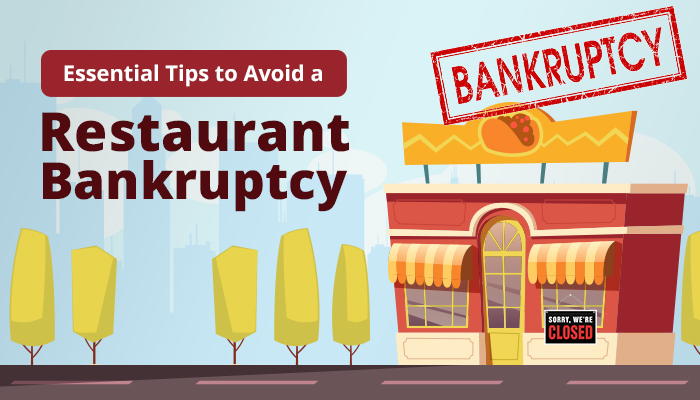The COVID-19 pandemic has brought havoc personally and financially to many businesses. Worldwide, lock-downs, drop in customer traffic, and other factors harmed so many businesses.
Unfortunately, the restaurant industry is one of the most affected. Many restaurants have closed and filed for bankruptcy.

If you are a restaurant owner and dealing with a financial crisis, other options can help.
First, let us understand the types of bankruptcies. Then we will cover what are the options to avoid filing bankruptcy.
Chapters of Bankruptcies
In the United States, there are three chapters or types of bankruptcies. A restaurant owner will have to choose which type of bankruptcy to file.
Chapter 7 – Liquidation
Chapter 11 – Business Reorganization
Chapter 13 – Adjustment of Debts for those who still have some revenue but not enough
Chapter 7 means ceasing all business operations. Here, the main objective is to liquidate the assets to pay debts. Bankruptcy court decides the debts that need to be paid first, including how much to pay.
Chapter 11 means a suspension of all or almost all the debts as the company tries to re-organize. The goal in this set-up is to try to turn around the tide and be profitable again. This way, the company can pay the debts. Chapter 11 is usually done by big businesses who sell assets. They then restructure into a smaller, more agile, and leaner company. By doing so, they become more cost-efficient. The company can bounce back and recover. Filing under chapter 11 bankruptcy needs to be submitted to the court. The judge needs to approve this.
Lastly, Chapter 13 is a scenario wherein the company is allowed to negotiate payments for their debts. Chapter 13 is used by businesses that still have some revenue coming in but not enough to pay rising debts. This can be useful for restaurant owners to still maintain their assets with the hope of recovering.
Process of Filing for Bankruptcy
The first thing to do by the restaurant owner is look and hire for a lawyer specializing in bankruptcy. Filing for bankruptcy is a long and tedious process.
After hiring your bankruptcy lawyer, the process begins with filing the necessary documents. Then pay the filing fee. Submit the papers to the right jurisdiction of the United States Bankruptcy court.
After filing the paperwork, file disclosure with the court. This is also very time-consuming.
Earlier, we mentioned that filing under Chapter 11 warrants a reorganization. This is also like Chapter 13. Hence, under these two chapters of bankruptcies, you need to come up with a solid plan. Show how you will re-organize the company. The plan should be comprehensive enough to also cover how to pay the debts and the length of time to pay.
Another requirement needed in filing bankruptcy is to provide information on business relationships, liabilities, and assets. These are no longer required for those falling under small businesses. Debt cap was increased to $7.5 million, which can cover most restaurants.
After filing all the papers, a confirmation hearing follows. The session will discuss the reorganization plan of the restaurant. It will also cover the paying off debts to creditors. The judge will give feedback if the plan will be accepted by the court or not. If approved, that is the only time the company can proceed with the plans shared.
Nevertheless, the restaurant owner should submit progress updates for any case.
Pros and Cons of Bankruptcy Filing
Being financially broke is heart-breaking. This is most especially true for restaurant owners who poured out a lot of effort in building their business. Filing bankruptcy even adds salt to injury. Hence, this should not be done without thinking it over clearly. Don’t decide on the spur of the moment of being emotional. There are pros and cons to filing bankruptcy that you have to carefully weigh.
Let us first discuss the pros. One advantage is that bankruptcy triggers an automatic stay. IT means that the creditors cannot take major action against the company. This includes repossessing your property, suing, threatening, or giving demands. Another advantage is that it can allow the company to dismiss obligations for some debts.
Now let us go to the cons of filing bankruptcy. One disadvantage is the risk that the restaurant can still be seized to pay off debts. Another one is the limit in the number of times a person can file bankruptcy. Allowed is only once every 8 years. Another disadvantage is that it affects the credit rating of the person for up to 10 years. This means it will be more difficult for the person to loan from the bank in the near future.
Other Options other than Filing Bankruptcy
One option to avoid filing bankruptcy is to avail of the US government’s CARES Act program. CARES Act or Coronavirus Aid, Relief, and Economic Security (CARES) Act helps restaurants deal with their financial situation. It offers tax relief and allows payment delays for social security taxes.
There is also the Paycheck Protection Program loan. This loan is for companies with less than 500 employees.
Other than these, the restaurant owner can still think of other ways. One way is to recapitalize the operation. Another way is to reinvent the business to meet this challenging time.
Lastly, you can also approach us at Sterling Debt Advisory. We can help you manage your debts. To know more about us, visit our site at https://sterlingdebtadvisory.com.au/

I am Arjun Kumar. I am the owner and administrator of Finance Gradeup. I have completed my education in Arts & Technology. Arjun Kumar usually has interests in playing games, reading and writing. He was a brilliant student during his college days. He also works for many private companies, but the main interest of Arjun Kumar is digital marketing. He thinks that reading is a must before providing any quality information to his readers. You can find Arjun Kumar on much social media handles online, or you can learn more about him in about us page.



